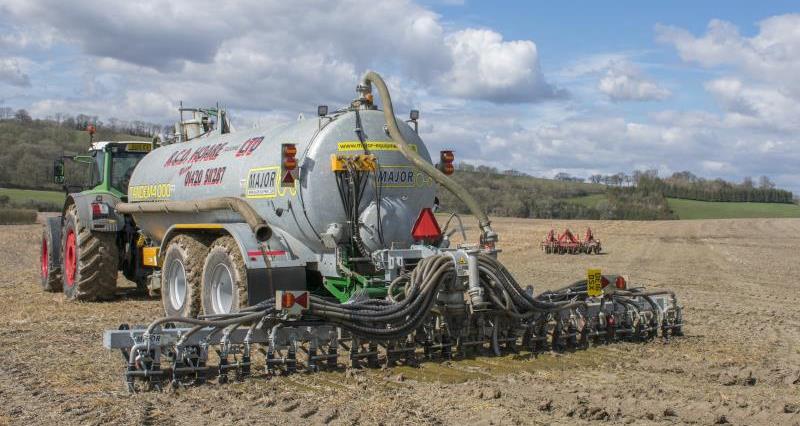Every farming business in England must comply with the Farming Rules for Water. Engaging in the active application of these rules when undertaking on farm activities will ensure that you are compliant and can help to reduce nutrient applications.
Introduced in 2018 across England, the Reduction and Prevention of Agricultural Diffuse Pollution (England) Regulations 2018, also known as the Farming Rules for Water, aim to prevent water pollution by stipulating that farmers in England must carefully plan manure and fertiliser applications to avoid exceeding the crop or soil need.
There are 8 farming rules for water which farmers must align with where required:
Rule 1: Planning use of manures and fertilisers
Rule 2: Storing organic manures
Rule 3: Applying manures or fertilisers
Rule 4: Where not to apply organic manures
Rule 5: Where not to apply fertiliser
Rule 6: Reasonable precautions to prevent soil erosion
Rule 7: Protecting against soil erosion by livestock
Rule 8: Position of livestock feeders
As part of the inspection of on farm activities undertaken by the Environment Agency's agricultural regulatory inspection officers, compliance with the Farming Rules for Water will be assessed where applicable as part of a farm regulatory inspection. Read our guide on what to expect from an EA inspection to find out more.
In 2022, the Secretary of State issued statutory guidance to the Environment Agency regarding the enforcement of the Farming Rules for Water. This guidance is non-statutory, and does not change the underlying legal requirements, but the EA must have regard to the guidance when making decisions on the enforcement of the rules.
Caution: legal challenge
The EA’s current approach to the enforcement of the Farming Rules for Water, and in particular the EA’s approach to the statutory guidance, is currently subject to a legal challenge. So, while the EA’s current position is that it will not ordinarily take enforcement action, beyond advice and guidance, where farmers are compliant with the statutory guidance, this may change in the future, depending on the outcome of the legal challenge. It is important that farmers monitor NFUonline and GOV.UK to ensure that they are familiar with the latest position.
The 8 farming rules for water
Rule 1: Planning use of manures and fertilisers
Rule 1 requires that application of organic manures and manufactured fertilisers to cultivated land must be planned to:
- meet soil and crop nutrient needs and not exceed these levels and
- not give rise to a significant risk of pollution.
Farmers must also take account of weather conditions and forecasts at the time of the application.
In assessing whether there is ‘significant risk of pollution’ farm managers must take into account the following factors:
- The slope of the agricultural land, especially if the slope is greater than 12 degrees.
- Any green cover.
- Proximity to inland fresh waters, coastal waters, and wetlands – You can use Magic Maps to assess proximity.
- Weather conditions and weather forecasts.
- Soil type and condition – improve organic matter to aid in nutrient retention.
- Presence and condition of agricultural land drains.
In addition, farmers must ensure that reasonable precautions are taken to prevent diffuse pollution. This includes:
- checking spreading equipment for leaks and calibration
- checking organic matter levels in, and moisture content of, soils, and
- incorporating organic manures within 12 hours of spreading, or as soon as possible, after application.
Your planning of nutrition applications must take into account where there is significant risk of pollution and the results of testing for phosphorus, potassium, magnesium, pH and nitrogen levels in the soil, which must be done at least every 5 years. You can determine soil nitrogen levels by assessing the soil nitrogen supply.
To fully understand the availability of nitrogen in your soils you can use a soil testing service to identify if there are opportunities to reduce nutrient applications which could save you money.
The NFU has partnered with NRM laboratories to offer a member exclusive discount on soil testing.
Rule 2: Storing organic manures
Organic manures must not be stored on land:
- within 10 metres of inland freshwaters or coastal waters
- where there is significant risk of pollution entering inland freshwaters or coastal waters, or
- within 50 metres of a spring, well or borehole.
Rule 3: Applying manures or fertilisers
Organic manures or manufactured fertilisers must not be applied:
- if the soil is waterlogged, flooded, or snow covered, or
- if the soil has been frozen for more than 12 hours in the previous 24 hours.
Rule 4: Where not to apply organic manures
Organic manures must not be applied:
- within 10 metres of any inland freshwaters or coastal waters, or within 6 metres of inland freshwaters or coastal waters if precision equipment is used, or
- within 50 metres of a spring, well or borehole.
Rule 5: Where not to apply fertiliser
Manufactured fertiliser must not be applied within 2 metres of inland freshwaters or coastal waters.
Rule 6: Reasonable precautions to prevent soil erosion
You should take all reasonable precautions to prevent significant soil erosion and runoff from:
- the application of organic manure and manufactured fertiliser
- land management and cultivation practices (such as seedbeds, tramlines, rows, beds, stubbles, including harvested land with haulm, polytunnels and irrigation), and
- poaching by livestock.
Rule 7: Protecting against soil erosion by livestock
Any land within 5 metres of inland freshwaters and coastal waters must be protected from significant soil erosion by preventing poaching by livestock.
Rule 8: Position of livestock feeders
Livestock feeders must not be positioned:
- within 10 metres of any inland freshwaters or coastal waters
- within 50 metres of a spring, well or borehole, or
- where there is significant risk of pollution from poaching around the feeder entering any inland freshwaters or coastal waters.
Planning applications of organic manures and inorganic fertilisers
Rule 1 requires that land managers ensure that, for each application of organic manure or manufactured fertiliser to agricultural land, the application:
- is planned so that it does not:
- exceed the needs of soil and crop on that land, or
- give rise to a significant risk of agricultural diffuse pollution, and
- takes into account the weather conditions and forecasts for that land at the time of application.
Examples of plans include nutrient management plans or other written plans which show that you have planned applications of organic manure or inorganic fertilisers in line with the Farming Rules for Water.
Plans should:
1. Have a tailored approach
The application plan should be tailored to the specific needs of the land and crop rotation. It should support decisions regarding the timing and quantity of organic manure and manufactured fertiliser application.
2. Assess crop nutrient requirements
Assess the nutrient requirements of each cultivated land parcel. This assessment should be based on reliable sources such as AHDB’s nutrient management guide (RB209), or recognised farm software such as PLANET, MANNER-NPK, or other nutrient management tools such as those provided by Tried and Tested.
3. Consider professional expertise
You can seek guidance from a qualified professional, such as an experienced agronomist or a FACTS (Fertiliser Advisers Certification and Training Scheme) adviser. Their expertise can contribute to a scientifically sound application strategy.
4. Incorporate soil sampling and analysis
Incorporate the results of soil sampling and analysis into your plan. This information will help fine-tune the nutrient application to match the soil's existing composition and ensure efficient uptake by the crops.
The results of any soil sampling and analysis must be less than 5 years old at the time the application takes place, so it is important to ensure that sampling and analysis takes place at appropriate intervals.
5. Show nutrient content consideration
Account for the nutrient content present in the applied organic manures and manufactured fertilisers.
The nutrient content of organic manure can be identified using available and suitable nutrient management tools or manure testing, such as laboratory analysis or near infra-red sensors for liquid manures.
Statutory guidance: assessment of your crop and soil needs when planning
Land managers should plan to avoid significant risk of diffuse agricultural pollution. This includes not exceeding the needs of the soil and crop on the land, but also takes into consideration other factors including soil type, the slope of the land and weather conditions.
The EA’s view is that soil and crop need must be immediate at the time of application. However, the statutory guidance issued by the Secretary of State allows nutrient applications to be planned based on needs over an appropriate future timescale, such as a crop cycle for the soil and crop’s need for nitrogen, provided this does not give rise to a significant risk of pollution.
The EA’s current position is that it will not usually prosecute farmers who have complied with the statutory guidance.
Defra’s statutory guidance says that, as a general rule, you should plan to avoid applying organic manures that raise the soil phosphorus index (soil P index) above target levels for soil and crop on land over a crop rotation, unless you can demonstrate that:
- it is not reasonably practicable to do so
- you have taken all appropriate reasonable precautions to help mitigate against the risk of diffuse agricultural pollution.
Statutory guidance: assessing the risk of agricultural diffuse pollution when planning
Plans should take account of how to avoid significant risk of agricultural diffuse pollution.
Defra’s statutory guidance includes the following:
Low RAN (readily available nitrogen) organic manure has a RAN content equal to or below 30%.
For applications of low RAN organic manure, the potential nitrate leaching risk linked to application rate will not usually be considered significant if all appropriate reasonable precautions are taken.
However, the amount of nitrogen applied should not exceed the needs of the soil and crop over an annual cycle.
High RAN organic manure has a RAN content above 30%. For applications of high RAN organic manure, the potential nitrate leaching risk linked to the application rate will not usually be considered significant if one of the following three criteria are met:
- The application is made outside of the time periods set out in Table 1, in which case no application rate limit would need to be enforced because of nitrate leaching risk
- The application is made during the time periods set out in Table 1 with a single application rate limit of 30m³/ha for high RAN organic manures in general and 8t/ha for high RAN poultry organic manures — there must also be no repeat applications for at least 21 days during the restricted time periods.
- The application is made during the time periods set in Table 1 at an application rate to meet the soil and crop need of an autumn/winter commercial crop, not including conventional cover crops or green manure.
In all cases, land managers must take all appropriate reasonable precautions to help mitigate against the risk of diffuse agricultural pollution.
Table 1: time periods when applicate rate limits apply for high RAN organic manure
| Soil type | Grassland | Tillage land |
| Sandy or shallow soil | 1 September to the end of February | 1 August to the end of February |
| All other soils | 15 October to the end of February | 1 October to the end of February |
While this guidance is not expressly set out in the legislation, it provides some insight into the approach that the EA is likely to take when considering enforcement decisions.
Statutory guidance: assessment of reasonable precautions
To reduce the risk of soil erosion during the winter months, land managers should aim to have established green cover by 15 October each year. Green cover can include any commercial crop, green manure, or cover crop. Appropriate crops are the decision of the land manager.
Where land managers are not planning to establish green cover by 15 October, appropriate justifications must be demonstrated for leaving land bare over winter. This can include agronomic or environmental reasons, such as:
- Delaying drilling to enable activities to control persistent weeds, such as blackgrass.
- Leaving medium and heavy soils to weather before a spring root crop.
Statutory guidance: incorporation of organic manures
Land managers should incorporate organic manures into soils as soon as reasonably practicable to act as a reasonable precaution against diffuse pollution unless there are appropriate agronomic or environmental reasons not to.
If applying low RAN organic manures, you may justify delaying incorporation if it is not practical to do so within 12 hours of spreading and if you have assessed relevant risk factors as not being significant over the application and incorporation period.
The statutory guidance suggests that circumstances where the incorporation of organic manures may not be appropriate include, but are not limited to:
- If it is applied to a growing crop or grassland.
- If precision application methods for manures are used which mitigate diffuse pollution as well as, or better than, incorporation.
Farmers will need to be able to demonstrate that they have a good justification for any decision to delay incorporation or not to incorporate manures.
For the full guidance, head to: GOV.UK | Applying the farming rules for water



